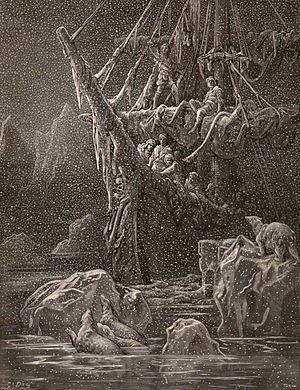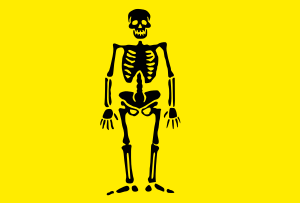George Shelvocke facts for kids
Quick facts for kids
George Shelvocke
|
|
|---|---|
| Born | Baptised 1 April 1675 Shropshire, England
|
| Died | 30 November 1742 (aged 67) London, England
|
| Nationality | British |
| Occupation | Naval officer and privateer |
| Known for | Inspiring The Rime of the Ancient Mariner |
George Shelvocke was an English sailor born in 1675 who died in 1742. He was a Royal Navy officer and later became a privateer. Privateers were like legal pirates; they had official permission from their government to attack enemy ships and keep what they captured.
In 1726, Shelvocke wrote a book called A Voyage Round the World by Way of the Great South Sea. This book shared his adventures, including a famous story about his second captain, Simon Hatley. Hatley shot an albatross bird near Cape Horn. This event later inspired a key part of the famous poem The Rime of the Ancient Mariner by Samuel Taylor Coleridge.
Contents
George Shelvocke was born into a farming family in Shropshire, England. He joined the Royal Navy when he was fifteen years old. During two long wars with France, he worked hard and moved up in rank. He became a sailing master and then a second lieutenant on a very important ship in the Mediterranean Sea.
However, when the war ended in 1713, he lost his job and struggled to find work. He was living in poverty when he was offered a chance to become the captain of a privateering ship called the Speedwell.
Adventures as a Privateer

In 1719, Shelvocke's ship, the Speedwell, joined another ship called the Success, captained by John Clipperton. Their mission was to capture Spanish ships and towns along the Pacific coast of the Americas. England was at war with Spain again, so their ships carried special papers called letters of marque. These papers gave them official permission to attack the Spanish and keep the treasures they found.
Soon after leaving Britain, Shelvocke separated from Clipperton's ship. He seemed to avoid contact with them for the rest of the journey.
On May 25, 1720, the Speedwell was badly damaged and stranded on an island called Más a Tierra. Shelvocke and his crew were stuck there for five months. But they were clever! They used parts from their wrecked ship and wood from local trees to build a new, smaller boat.
They left the island on October 6. They soon captured another ship, which they renamed the Happy Return. Even though the war had officially ended in February, making their permission to attack ships invalid, they continued their privateering. They sailed up the coast of South America, from Chile to Baja California, capturing more ships. After that, they crossed the Pacific Ocean to Macao and finally returned to England in July 1722.
Later Life and Legacy
When George Shelvocke returned to England, he faced some problems. Some of the main investors in his voyage suspected he had kept a large part of the treasure for himself and his crew. While he was questioned about this, he managed to settle things without being found guilty.
Shelvocke wrote his book, A Voyage Round the World by Way of the Great South Sea, to explain his side of the story. However, some people who were with him on the voyage, like his captain of marines, William Betagh, disagreed with his version of events.
Despite these issues, Shelvocke rebuilt his reputation. He died on November 30, 1742, at the age of 67. He had become a wealthy man from his adventures. His tomb in St Nicholas, Deptford, London, praised him as "a gentleman of great abilities in his profession and allowed to have been one of the bravest and most accomplished seamen of his time." His son, also named George Shelvocke, who had joined his father on the voyage, later became an important official and a member of the Royal Society.
How Shelvocke Inspired a Famous Poem
In his book, George Shelvocke described an important event. While his ship, the Speedwell, was trying to sail around Cape Horn during a bad storm, his second captain, Simon Hatley, shot a black albatross. Hatley believed the giant sea bird was a bad omen and hoped killing it would make the weather better.
About seventy years later, this exact incident became the main idea for Samuel Taylor Coleridge's famous poem, The Rime of the Ancient Mariner. Coleridge's friend, the poet William Wordsworth, shared how the idea for the poem came about:
Much the greatest part of the story was Mr Coleridge's invention; but certain parts I myself suggested: for example, some crime was to be committed which should bring upon the old navigator, as Coleridge afterwards delighted to call him, the spectral persecution, as a consequence of that crime, and his own wanderings. I had been reading in Shelvock's Voyages a day or two before that while doubling Cape Horn they frequently saw albatrosses in that latitude, the largest sort of sea-fowl, some extending their wings twelve or fifteen feet. "Suppose," I said, "you represent him as having killed one of these birds on entering the South Sea, and that the tutelary spirits of those regions take upon them to avenge the crime. The incident was thought fit for the purpose and adopted accordingly."


